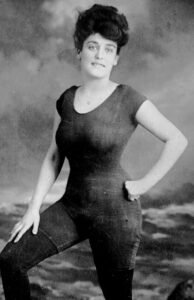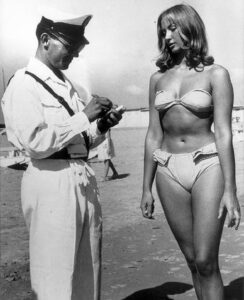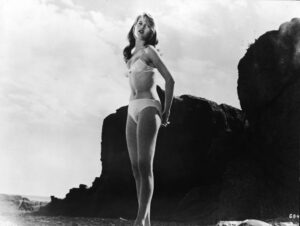One tiny garment. That’s all it took to spark outrage, bans, and even arrests across the globe.
In the decades-long tug-of-war between modesty and freedom, the bikini emerged as both villain and victor. Popes called it sinful. Governments outlawed it.
But women kept wearing it — and with every bold appearance, they rewrote the rules.
Tailors on the beaches
At the dawn of the 20th century, swimsuits were far from the sleek, stylish designs we know today. Back then, they were bulky, full-body garments made from wool, designed to keep swimmers covered and protected from the sun. This wasn’t about fashion — it was about modesty.
Strict dress codes were common at beaches across the U.S. According to Kathleen Morgan Drowne and Patrick Huber in their book on 1920s pop culture, places like Chicago’s Clarendon Beach even hired tailors to make on-the-spot adjustments to swimsuits deemed too revealing.
Similar rules popped up nationwide — Coney Island, for example, banned bathing socks in 1915 if they exposed “dimpled knees.” In Washington, DC, beach police were known to enforce these codes with tape measures in hand.
Arrested for a one-piece?
The early 1900s were all about covering up. Men and women alike were expected to wear suits that went from neck to knee — no exceptions. If any skin was exposed? Well, that was considered scandalous.
But change was on the horizon. In 1907, Australian swimmer Annette Kellerman became one of the first to challenge these norms when she wore a one-piece suit that revealed her arms, legs, and neck, instead of the then-accepted pantaloons.
Nicknamed “the Australian Mermaid” for her remarkable swimming skills, Kellerman spent much of her life challenging societal norms and redefining ideals.

According to Kellerman herself, she was arrested by the police for wearing her ”indecent” outfit, although there are no official reports to confirm this. Nevertheless, it caused a scandal at the time for a woman to swim in such a manner. The incident made headlines and sparked a movement.
Kellerman’s daring swimwear choice captured the public’s attention, and soon, her one-piece suits became a popular trend.
The demand grew so much that she eventually launched her own swimwear line, and the ”Annette Kellermans,” as they came to be known, marked the first step toward the evolution of modern women’s swimwear.
The roaring ‘20s: A new wave of fashion
As the 1920s roared on, the flapper style started making waves, not just in evening wear, but at the beach too.
It all started when a group of rebels from California rose up against tradition. Known as the ”skirts be hanged girls,” their revolutionary goal was simple: swimsuits that women could actually swim in.
So, swimwear began to shift, becoming more practical and form-fitting. The ”skirts be hanged girls” symbolized a nationwide shift that was about more than just fashion — it was about functionality and freedom of movement.
While it was still modest by today’s standards, women were slowly showing more skin, with swimsuits that were designed for freedom of movement. But the true revolution was yet to come.
The bikini: A scandalous step forward
Then came 1946, and with it, the birth of the bikini. Invented by French engineer Louis Réard, this two-piece swimsuit exposed the navel and flaunted more skin than anyone thought was appropriate for public spaces.
Just days before the bikini was introduced in 1946, the U.S. conducted its first peacetime nuclear test at Bikini Atoll, drawing global attention.
Although designer Louis Réard never explained why he named the swimsuit “bikini,” many believe it was a nod to the explosive impact he hoped it would have — both commercially and culturally — much like the bomb itself. Others suggest the name evoked the exotic appeal of the Pacific or compared the shock of a revealing swimsuit to the power of an atomic blast.

The reaction in the U.S. was swift: many beaches banned the bikini, and it was seen as downright rebellious. And things weren’t much easier in Europe. In 1949, France prohibited bikinis on its beaches, and in Germany, they were banned from public pools until the 1970s. At the same time, certain communist groups slammed the bikini as a sign of capitalist decadence and moral corruption.
Pope Pius XII declared the bikini sinful, and several countries — among them Belgium, Italy, Portugal, and Spain – enforced nationwide bans on the swimsuit.
In a well-known 1952 incident, Australian model Ann Ferguson was asked to leave the beach at Surfers Paradise because her Paula Stafford bikini was considered too revealing.
Truth about the famous photo
One photo has come to symbolize the entire debate over whether bikinis belonged on public beaches — or not. And it comes from Italy.
The black-and-white image, which has gone viral in recent years, shows a man in a white uniform standing beside a young woman in a bikini on a beach. Social media users often claim the moment was captured in Rimini, Italy, in 1957. The most shared version of the story says the man is a police officer writing the woman a ticket for nothing more than wearing a bikini.
A 2023 Reddit post featuring the image racked up over 31,000 upvotes and 1,400 comments. Its caption read: “A police officer issues a ticket to a woman for wearing a bikini, 1957.”

But was it real?
The photo itself is authentic — there’s no sign of digital tampering — but the backstory remains a mystery. There’s no solid proof the woman was ticketed for her swimwear. Some suspect it may have been a staged scene with models or actors, while others believe the officer could’ve been citing her for a completely different reason.
Still, the photo hit a nerve.
In an email, Gianluca Braschi, director of the State Archives of Rimini, confirmed to Snopes that Italy did have swimwear laws in place at the time, even if the story behind the photo remains unclear.
As Braschi explained, a 1932 law forbade “bathing in public view in a state of complete nudity and with indecent swimwear.” That law technically remained on the books until 2000, though enforcement was inconsistent.
So, while we may never know the full story behind that viral moment, it reflects a very real tension from the era, one where bikinis didn’t just turn heads… they could also get you in trouble.
The Hollywood influence
It wasn’t until the 1960s that the bikini really became popular. Cultural shifts opened the door for more daring swimwear styles.
But even then, public opinion was split. More conservative areas pushed back against the tiny two-piece.
One example is the United States Motion Picture Production Code — better known as the Hays Code — which was enforced starting in 1934. While it allowed two-piece outfits in films, it strictly banned any showing of the navel. Adding to the pressure, the National Legion of Decency, a Roman Catholic watchdog group, urged Hollywood and international filmmakers to keep bikinis off the big screen entirely.
The rise of Hollywood stars like Marilyn Monroe, Ursula Andress, and Brigitte Bardot helped redefine the standards of beauty and body confidence. These icons didn’t just wear swimsuits — they became synonymous with them.
The Girl in the Bikini
Perhaphs no one did more to launch the bikini into global stardom than French-born actress Brigitte Bardot.
It wasn’t just that she wore a bikini, it was how she owned it. In her breakout role in The Girl in the Bikini, Bardot didn’t just wear the swimsuit; she turned it into a cultural statement. Her figure, poured into a strapless, diamond-shaped bikini top that looked like it could give way at any moment, was the centerpiece of the film.
With long, tousled hair and a carefree presence, Bardot wasn’t just acting — she was rewriting the rules of how women could be seen on screen.
The movie made sure to show her in harmony with the ocean and the sun, but let’s be honest: it was her body the camera adored. The film framed her in classic pin-up style, yet Bardot wasn’t just eye candy, she became the first actress to center a bikini in a leading role and give it a narrative arc.

Brigitte Bardot wears a white bikini and stands on a rocky beach in a still from the film, ‘The Girl in the Bikini’, directed by Willy Rozier, 1958. (Photo by Atlantis Films/Pictorial Parade/Courtesy of Getty Images)
While she wasn’t the first woman to wear one, Bardot was the first to make the bikini iconic through storytelling, and that film’s impact in the U.S. launched her into instant international fame.
Ursula Andress’s white bikini from Dr. No (1962) became an instant icon because it combined sex appeal, strength, and cinematic impact in a way audiences hadn’t seen before.
When she emerged from the sea with a knife strapped to her hip, Andress wasn’t just eye candy — she was powerful, self-assured, and unforgettable. The moment defined her as the ultimate Bond girl and cemented the bikini as a symbol of bold femininity in pop culture.
By the 1970s, the bikini was everywhere. Swimsuits got even more revealing, with string bikinis and thong-style bottoms entering the scene. Men’s swim trunks also shrank, as the “modesty” of the early 20th century became a thing of the past.
Swimsuits today: Body positivity and diversity
Fast forward to the 21st century, and swimwear is no longer just about adhering to societal norms. The swimwear market has exploded into a world of choice.
From modest one-pieces to string bikinis and daring thongs, there’s something for everyone. What’s more, the conversation around body types has evolved significantly. Today, it’s about comfort, confidence, and body positivity, with people of all shapes, sizes, and backgrounds expressing themselves freely at the beach or pool.
Gone are the days of regulating ”decent” swimwear. Now, it’s all about personal choice and self-expression. Whether it’s a full-coverage swimsuit or the most revealing bikini, America’s changing views on modesty reflect a much more inclusive and accepting society.
What started as a battle for modesty has evolved into a celebration of diversity, individuality, and freedom. So next time you hit the beach, remember: it’s not just about the swimsuit — it’s about the journey to self-expression that it represents.





